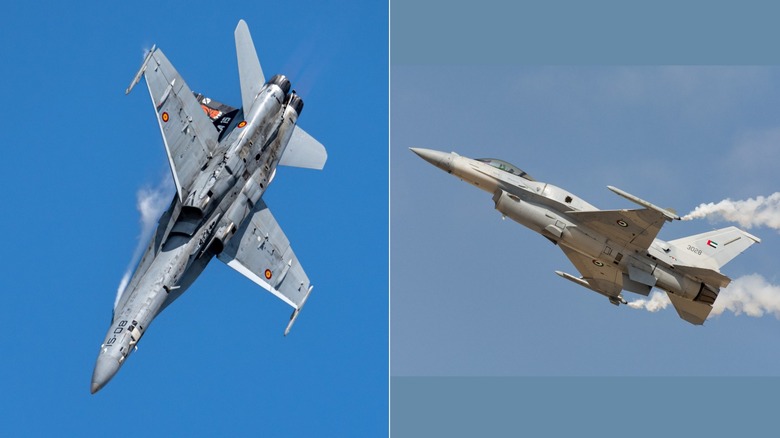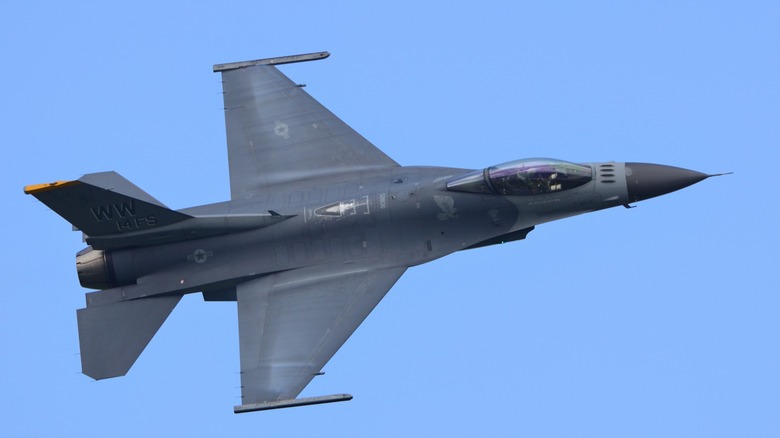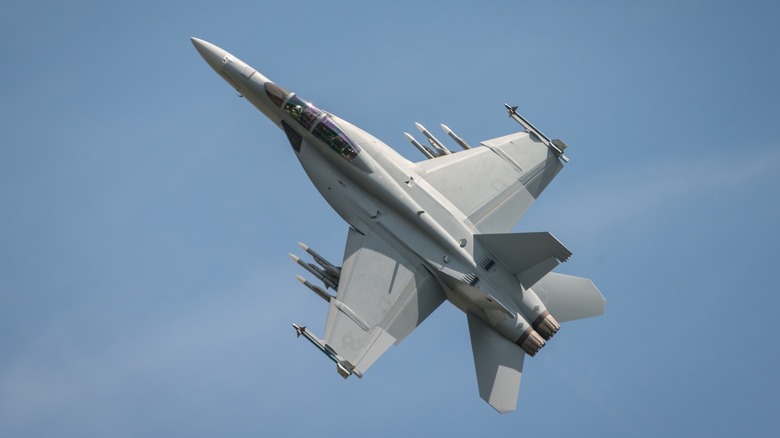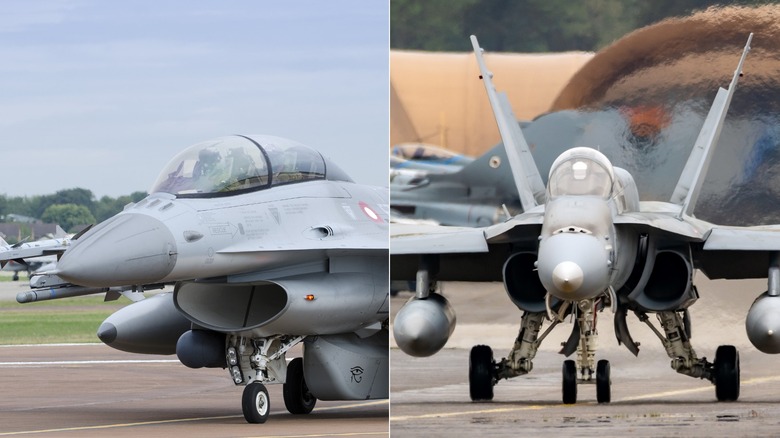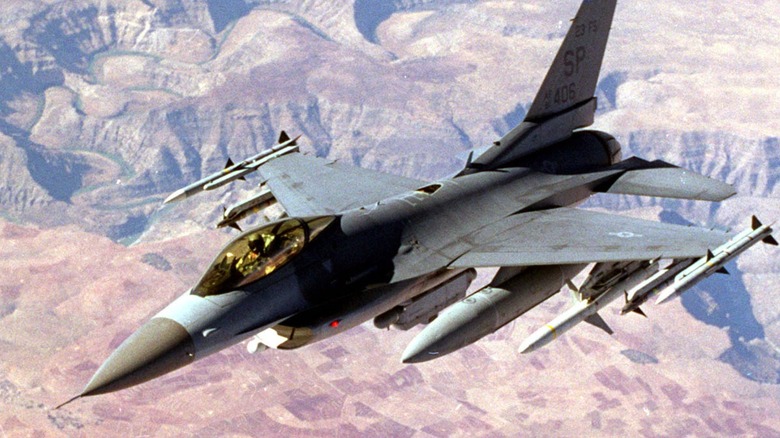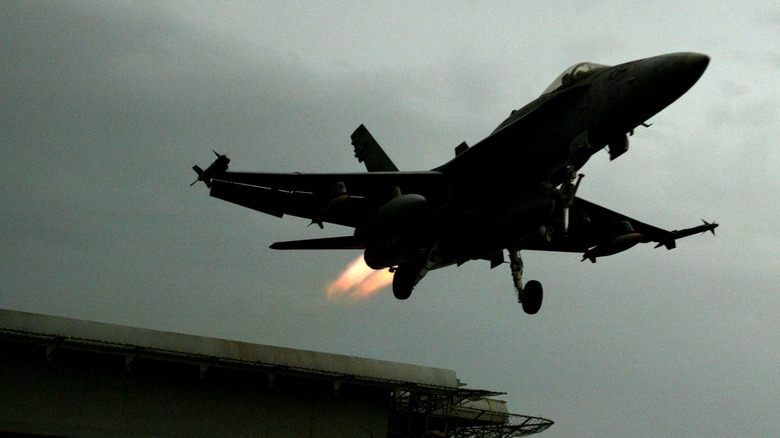Biggest Differences Between F-16 & F-18 Fighter Jets
The F-16 Fighting Falcon is the world's most popular fighter jet, with over 2,100 serving active roles in various air forces. On the other hand, the F-18 Hornet (or Super Hornet for the later variants) is the fourth most popular, with 836 airframes between Australia, Canada, Finland, Kuwait, Malaysia, Spain, Switzerland, and, of course, the U.S.
Despite being operated globally by many governments' militaries, most of us would equate both jets with American air power. But why did the U.S. need to make two different fighter aircraft types? Since both planes are fighter jets, why not just use one plane and get rid of the other? The answer is that they're quite different.
So, let's compare the F-16 and the F-18, and see why America needs both planes to retain its strategic edge. Aside from the physical differences between the two planes, we'll also look at their mission profiles to see why both jets are needed in the U.S. military's arsenal.
What is the F-16 Fighting Falcon?
The F-16 Fighting Falcon is a single-engine, single-seat multi-role fighter first manufactured by General Dynamics, but it has since been taken over by Lockheed Martin. The F-16 was envisioned as a low-end fighter (cheaper, more affordable) to the Air Force's high-end F-15 Eagle air superiority fighter.
While it was initially designed as an air-to-air fighter, it has since been modified to accomplish other missions. The Air Force first received the F-16 in 1978, meaning these jets will hit 50 in just a few years. However, they're still in use today and will likely see combat against Russia when Ukraine gets them this year. Other countries, like Turkey and the Philippines, are also considering purchasing these aircraft, especially as Lockheed has kept them updated for modern battlefields with the F-16 Block 70/72 Viper model. There are also two-seat variants of the F-16, namely the F-16B and the F-16D, , which are primarily used for training but can still be employed in combat missions.
The F-16 design is so successful that it spawned another variant, the Mitsubishi F-2. This aircraft was made by Mitsubishi Heavy Industries, the same company that built the Mitsubishi A6M Zero, one of the most legendary naval aircraft ever, in partnership with Lockheed Martin. General Dynamics also pitched F-16-based contenders for other fighter programs, including the Vought Model 1600 (in partnership with Vought and competed against the Northrop-McDonnell Douglas YF-17-based Model 267, which became the F/A-18) for the U.S. Navy's carrier-based fighter program and the F-16XL to compete against the F-15E Strike Eagle for the Air Force's Enhanced Tactical Fighter program.
What is the F/A-18 Hornet and Super Hornet?
The F/A-18 Hornet and newer Super Hornet variants were built from the ground up as all-weather fighter and attack aircraft, hence the F/A (F for fighter and A for attack aircraft) designation. And while other countries' air forces fly the F/A-18 from land, it was primarily built for the U.S. Navy as a carrier-borne aircraft.
Nevertheless, it was the U.S. Marine Corps that was the first to receive this aircraft in 1983, and the Navy got it the following year. The F/A-18 also came in several flavors—The F/A-18A and F/A-18C are single-seat variants, while the F/A-18B and F/A-18D had two seats. The B model was primarily used for training, while the A, C, and D models were used for combat and reconnaissance missions.
In 1999, the latest iteration of the Hornet arrived on the scene with the F/A-18E/F Super Hornets. These models were so good that the U.S. Navy ordered more of these jets 25 years later in 2024. Aside from these attack aircraft, the F/A-18 also spawned an electronic warfare version, called the EA-18 Growler.
What are the physical differences between the F-16 and the F/A-18?
The most obvious difference between the F-16 and the F/A-18 is the number of engines. The F-16 Fighting Falcon has a single engine with its intake sitting prominently under its belly. On the other hand, the F/A-18 has two engines with the intakes on either side of the rear half of the fuselage.
Aside from this, the F-16 only has one large tail while the F/A-18 has a twin tail configuration. One advantage of the F/A-18's two tails is that it can be shorter compared to jets with one single tail. Since space is limited on aircraft carriers, these smaller tails make it easier to move and store jets below deck. Furthermore, it helps reduce weight and complexity, as the aircraft maker doesn't need to add a folding mechanism for the tail.
One more thing you'll notice about the F/A-18 is its extra beefy landing gears and thick arresting hook. The F/A-18 is built for carrier operations, so it needs to be able to stop on the dime. Even though aircraft carriers are some of the largest ships in the world, they're still pretty short at just around 300 meters long. So, the Hornet (and the Super Hornet) requires thick legs to ensure that they can withstand the heavy landings these jets make at sea, especially while a ship is being tossed about by the ocean.
What missions does the F-16 fly?
Although the F-16 started as an air-to-air fighter, its capability has grown and can do several other things now. The U.S. Air Force calls the F-16 Fighting Falcon a compact, multi-role fighter aircraft, which gives us a clue on how versatile this jet is. This plane has been tested in actual combat and has faced air-to-air battles and taken air-to-ground missions, allowing it to do almost anything.
Some of the things that the F-16 can do include "Wild Weasel" SEAD (or Suppression of Enemy Air Defenses), close air support, forward air control, and counter-air missions. F-16s can also be configured to carry the B61 Nuclear Gravity bomb, allowing the aircraft to conduct tactical nuclear strikes inside enemy territory.
The F-16 can also be refueled from Air Force tanker aircraft, allowing it to extend its range as needed. However, it takes on fuel via a boom, so it cannot accept fuel from U.S. Navy aircraft that only use the hose-and-drogue method to refuel other planes.
What can the F/A-18 Hornet do?
Like the F-16, the F/A-18 is a multi-role fighter that can do a lot. The F/A-18B model is primarily used for training pilots to operate the jet, but the F/A-18A, C, and D, are combat-focused jets that can take on air-to-ground attack roles, provide close air support, suppress enemy air defense, and strike naval and maritime targets.
They're also used for air superiority missions, as fighter escorts, and to serve as fleet air defense protect the Carrier Strike Group. Other missions that the F/A-18 can accomplish include airborne forward air controller and reconnaissance missions. It's also the aircraft that the Navy uses for aerial refueling via buddy stores, allowing other Navy aircraft to take off with heavier loads (i.e., carry more weapons) and then top-up tanks once airborne to extend mission range.
Of course, we can't forget the EA-18G Growler, which is basically an F/A-18F Super Hornet reconfigured to deliver massive electronic interference to enemy radar screens. This aircraft ensures that the adversaries cannot see other U.S. aircraft coming into attack, helping them avoid detection and giving their pilots a greater chance in accomplishing their missions.
The F/A-18 Hornet and Super Hornet aircraft were more suitable for the Navy's need, like their twin-engine configuration and smaller intakes (which meant less chance of sucking up an inattentive deck crew), that's why the Navy didn't choose the F-16 (or its carrier-based variant). Despite the efforts to create a unified fighter jet with the F-35, the needs of the various services (Air Force, Navy, and Marine Corps) mean that it's highly difficult to create a single plane that can meet everyone's requirements — that's why the Lightning II variants have little in common.
